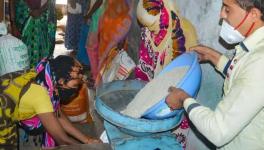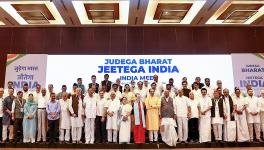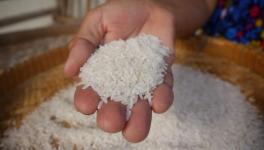Nutrition: In Budget 2020, Rhetoric Beats Reality Again
Everyone, including the government, recognises the special health and nutrition needs of adolescent girls. The only trouble is, the Union government forgets this at the time of actually providing funds for nutrition. Why else would the government cut the funds for the specific schemes for nutrition to only a half of the original allocation?
In the budget for the financial year 2019-20 a sum of Rs 300 crore was allocated (Budget Estimate or BE) for Sabla, the main scheme specifically meant to boost the health and nutrition needs of adolescent girls. When the Revised Estimates for this year (or the RE) were prepared, this was cut to Rs 150 crore, no explanation given.
The BE for this scheme for 2020-21 is Rs 250 crore, and this has been falsely represented as an increase by comparing it with the RE rather than the BE of the past year. The allocation this year is actually less than the allocation made last year by Rs 50 crore. What is more, the actual expenditure of the Union government on this scheme was Rs 622 crore way back in 2014-15 and in 2016-17 it was Rs 482 crore. This shows the great extent in cuts in allocation in recent years.
Again, the importance of maternal health and nutrition is well-recognised, as is the fact that the PMMVY scheme (or Pradhan Mantri Matru Vandana Yojana), if properly implemented, can make an important contribution to this end. But first the coverage was reduced to cover only the first child, then the per-mother grant (which is given in three instalments) was also reduced.
By narrowing the scope of PMMVY, most children who are being born now are not covered by it. Nevertheless, even if it only covers the first birth, it remains an important scheme. An allocation of Rs 2,500 crore was made in the previous year, which was cut to Rs 2,300 crore, and it is back to Rs 2,500 crore this year. A study by Jean Dreze and Reetika Khera has noted that only 51% of eligible beneficiaries were enrolled under the scheme in 2018-19 and of them only 61% received all three instalments.
The Prime Minister’s Overarching Scheme for Holistic Nutrition, known as POSHAN Abhiyan, is a repackaged version of the earlier National Nutrition Mission. The government calls it a high-priority “convergence” scheme. However a review by the Accountability Initiative (within the Centre for Policy Research) has revealed that in financial year 2019-20, until November 2019, no central funds were released for 15 states for this scheme. The states included, among others, Jharkhand, Chhattisgarh, Odisha, Uttar Pradesh, Rajasthan and West Bengal.
This review also finds very low utilisation and further that 72% of the expenditure was accounted for by Information and Technology Related Real-Time Monitoring, Community-Based Events etc. That is, a bulk of the money meant to improve the nutrition standards have been spent on purchases of smartphones and gadgets.
The allocation for the National Creche Scheme this year has gone up to Rs 75 crore compared to Rs 50 crore in the previous year, but to put this in perspective, the actual expenditure in 2015-16 was Rs 133 crore and in 2016-17 Rs 125 crore. So there has been a big reduction in funding this scheme, which continues this year.
For Anganwadi Services (the core of the Integrated Child Development Scheme) the BE of Rs 19,834 crore last year was cut to RE of Rs 17,705 crore. In the new budget the BE is Rs 20,532 crore. Now compare the actual expenditure during 2014-15 (Rs 16,664 crore) with the Revised Estimate of 2019-20 (Rs 17,705 crore). It turns out that over the five-year period, there has been a clear decline in actual spending, after providing for the impact of inflation, while the number of children and mothers to be covered has increased. There is a clear need for more centres and sub-centres, for example to cover Dalit hamlets and those where other weaker sections reside and remote areas.
As the Centre’s contribution for salaries of Anganwadi workers has declined, many states with difficult fiscal situation face increasing difficulties in mobilising adequate staff.
In the case of the scheme for mid-day meals, the BE last year was Rs 11,000 crore, which was cut in the RE to Rs 9,912 crore. This can be compared to the actual expenditure of Rs 10,523 crore in 2014-15. So this amounts to a decline in real and per-capita terms. This decline should be noted in the context of the oft-repeated need to extend the scheme to higher classes. There are concerns that below-subsistence wages are being paid to the women who cook the mid-day meals, and therefore keep this program going despite great difficulties.
The BE for food subsidy last year was Rs 1,84,220 crore while the RE was cut to Rs 1,08,688 crore. This year the BE is Rs 1,15,570 crore. Compared this to the actual expenditure of Rs 1,39,419 crore in 2015-16. To understand the emerging situation keep in mind that the Food Corporation of India has been borrowing heavily from the National Small Savings Fund (and from other sources), an undesirable trend. This can jeopardise the sustainability of providing cheap food-grains to a substantial section of the population.
Despite these disturbing trends and concerns, officially, the situation presented is of a very generously-funded nutrition program by a benevolent government. But then, aren’t we living in times when rhetoric gets the better of reality. Unfortunately, this is happening at the cost of health and food security of the population and future generations. If problems are not even recognised, real, effective, justice-based reforms are out of the question.
The writer is a freelance journalist who has been involved with several social movements. The views are personal.
Get the latest reports & analysis with people's perspective on Protests, movements & deep analytical videos, discussions of the current affairs in your Telegram app. Subscribe to NewsClick's Telegram channel & get Real-Time updates on stories, as they get published on our website.
























